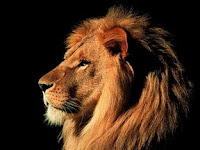In my studies, I’ve been captivated by the way God is described using analogies. That is, His Word uses ordinary words to help me understand Him, words that by themselves would not do that, but because they are given and understood in the power of God’s Spirit, I can know something about His character, His essence. Today’s Scripture passage gives an example of this analogical language . . .
And one of the elders said to me, “Weep no more; behold, the Lion of the tribe of Judah, the Root of David, has conquered, so that he can open the scroll and its seven seals.” And between the throne and the four living creatures and among the elders I saw a Lamb standing, as though it had been slain, with seven horns and with seven eyes, which are the seven spirits of God sent out into all the earth. (Revelation 5:5–6)
God the Son is described in vivid picture language. He
is a lion, a root, a conqueror, yet also a very unusual lamb. These,
particularly the Lion of the tribe of Judah and the Lamb that has been slain,
say much about the nature and character of Jesus Christ.
 The title of Lion may have come from Jacob’s blessing
on his son Judah using reference to a lion, likely because of the valiant
future of his descendents. Jesus came from his lineage. He is called the root
of David as David also came from this lineage. However, the “lion” designation
also describes a strong, majestic animal. A lion was used as the symbol for Christ
in The Chronicles of Narnia by C. S.
Lewis, a popular fiction series. We call lions the king of beasts.
The title of Lion may have come from Jacob’s blessing
on his son Judah using reference to a lion, likely because of the valiant
future of his descendents. Jesus came from his lineage. He is called the root
of David as David also came from this lineage. However, the “lion” designation
also describes a strong, majestic animal. A lion was used as the symbol for Christ
in The Chronicles of Narnia by C. S.
Lewis, a popular fiction series. We call lions the king of beasts.
However, Jesus is also called a Lamb. I notice that the
Lion was able to open the book in the vision from Revelation, but it was the
Lamb that actually did it. When this Lamb acted, those around the throne sang a
new song . . .
Worthy are you to take the scroll and to open its seals, for you were slain, and by your blood you ransomed people for God from every tribe and language and people and nation, and you have made them a kingdom and priests to our God, and they shall reign on the earth. (Revelation 5:9–10)
A lion can be thought of as a devourer that slaughters
others, even defenseless lambs, yet Christ is represented as both, even a lamb that
had the marks of one who had been slain. This brings together a picture of Christ’s
admirable virtues. The lion may excel in strength, but the lamb excels in
meekness and patience. It suggests also a source of food and wool, but mostly a
suitable offering for sacrifice. The context suggests what the rest of Scripture
confirms, that the sacrifice of the Lamb makes Jesus worthy of our worship.
Another verse shows more of this language.
For to us a child is born, to us a son is given; and the government shall be upon his shoulder, and his name shall be called Wonderful Counselor, Mighty God, Everlasting Father, Prince of Peace. (Isaiah 9:6)
These multiplied images show a conjunction of virtues
in the same Person. That is, Jesus is a son but also the everlasting Father. He
is a child yet rules the world as Prince of Peace. He is a Wonderful Counselor
and the Mighty God, all in the same Person.
It is from the analogies used in the Bible that I
understand that God is more than words can describe. He is called by a variety
of names and represented with a variety of descriptions because no one name or
image can give me a complete picture. Even with those, I get it that God is
beyond human understanding, yet amazing in that he perfects ordinary language
to the degree that it can be used in His Word and by His Spirit to speak of who
He is.

No comments:
Post a Comment